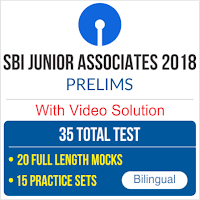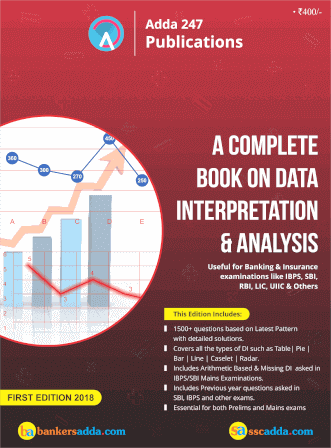SBI Clerk Prelims Examination is scheduled to be held in the month of March or April. Many of you must be concerned about your performance in Quantitative Aptitude Section. As the there is no sectional cut off in Prelims Examinations this year, the ones who are weak at quants must be ignoring quant section for sure. Students, do not forget that in this exam, you have to clear the overall cut off that can only be achieved if you have performed fairly well in all the three sections. Syndicate and Canara Bank PO Exams too are queued up to be held in the upcoming days and Quantitative Aptitude Section is the one that lets you attempt the maximum number of questions with a high accuracy. To let you know what topics you need to do to perform well in Quant Section, we, team Bankersadda are providing you all with the questions on the most important topics that are likely to be asked in the upcoming SBI Clerk, Syndicate Bank PO, and Canara Bank PO Exam 2018.
The level of every other section is only getting complex and convoluted, there is no doubt that this section too will be making your blood run cold, especially when one will have only 20 minutes for this section in SBI Clerk Prelims Exam. But one should not forget that a mix of accuracy and a good number of attempts can definitely turn the situation around in Quantitative Aptitude Section. The only way to score satisfactory marks in the section is strenuous practice. Here are the most important topics of Quantitative Aptitude that will be asked in the SBI Clerk, Syndicate Bank PO, Canara Bank PO and other Banking Examination.
1. Approximation and Simplification
a. Simplification (IBPS CLERK PRE 2017)
Direction: Simplify the given question and identify what value should come in the place of question mark (?) in the questions given below?
Q. 40% ?? ( 20/ 4 ×? ) = 48
(a) 20
(b) 24
(c) 28
(d) 32
(e) 22
b. Approximation (RRB PO PRE 2017, CLERK MAINS 2017, IBPS PO PRE 2017)
Direction: What approximate value should come in the place of question mark (?) in the questions given below?
Q. 24.987% × 639 + 45.21% of 359 = ?
(a) 358
(b) 378
(c) 322
(d) 302
(e) 288
2. Number Series
a. Missing Number Series (IBPS PO PRE 2017, RRB PO PRELIMS 2017, IBPS CLERK PRE 2017, IBPS CLERK MAINS 2017)
Direction: What will come in place of the question mark (?) in each of the following series?
Q. 8, 4, 4, 8, 32, ?
(a) 512
(b) 128
(c) 248
(d) 256
(e) 232
b. Wrong Number Series (IBPS PO Mains 2017, RRB PO MAINS 2017)
Direction: Find the wrong term in the following series.
Q. 4,6,12,30,60,315,1260
(a) 12
(b) 1260
(c) 60
(d) 30
(e) 315
3. Inequality
a. Quadratic Equation (IBPS PO Prelims 2017, IBPS RRB PO PRE- 2017, IBPS CLERK MAINS 2107)
Direction: Two equations (I) and (II) are given. You have to solve both the equations and give answer
(a) if x > y
(b) if x ≥ y
(c) if x < y
(d) if x ≤ y
(e) if x = y or relationship between x and y cannot be established
b. Inequality (SBI PO MAINS 2017 and IBPS PO Mains 2017)
Q. Quantity I: ‘x’: X, Y and Z can finish a work alone in 12, 18 and 9 days respectively. X started the work and Y and Z assisted him on every 3 days. ‘x’ is total days in which work is completed.
Quantity II: ‘y’: A, B and C can finish a work alone in 20, 12 and 15 days respectively. All three starts working together. After 2 days B left the work, after 4 more days C left and remaining work is completed by A alone. A worked for ‘y’ days is total.
(a) Quantity I > Quantity II
(b) Quantity I < Quantity II
(c) Quantity I ≥ Quantity II
(d) Quantity I ≤ Quantity II
(e) Quantity I = Quantity II or No relation
4. Data Interpretation
Types of DI:
1. Pie Charts
2. Line Graph
3. Bar Graphs
4. Tabular
5. Radar DI
6. Caselet DI
7. Missing DI
a. Tabular DI (IBPS CLERK PRELIMS 2017, IBPS PO PRELIMS 2017)
Directions: The following table shows number of pets sell by four sellers. Study the data carefully & answer the following question

Q. Pets sold by A and B in the month of June is how much more than pets sold by C in May and July together?
(a) 16
(b) 32
(c) 44
(d) 34
(e) 22
b. Pie Chart
- Single Pie Chart (IBPS CLERK PRE- 2017)
Directions: Study the pie-chart and solve the following questions:
Q. JIO users in Punjab and Assam together is what percent less than JIO users in UP and Goa together.
(a) 30%
(b) 6%
(c) 10%
(d) 15%
(e) 25%
- Double Pie Chart (IBPS RRB PO MAINS 2017)
Directions: Study the following pie charts and answer the questions that follow:
Given below are two pie charts which shows the percentage distribution of cricket players and football players in 6 sports club out of the total cricket and football players respectively in these six sports club.
Note:1- If it is said that number of players playing “either” football or cricket than it means sum of players playing football and cricket.
2- No players play both games.

Q. What is the difference between the total number of players playing either Football or Cricket from club D and those playing Football from club C and E together?
(a) 152
(b) 160
(c) 165
(d) 172
(e) None of these
c. Caselet D.I. (IBPS CLERK MAINS 2017)
Directions: Study the following information carefully to answer the questions that follow:
In a school there are 800 students who have visited five different cities viz. Delhi, Ajmer, Varanasi, Mumbai and Jodhpur. Fifty-four per cent of the total students are boys. One fourth of the total number of girls visited Mumbai. Twenty-five per cent of the total number of girls visited Delhi. Number of girls who visited Jodhpur is half the number of girls who visited Delhi. Five-sixth of the remaining girls visited Ajmer. Total number of students who visited Mumbai is 192. One-fourth of the total number of boys visited Varanasi. 101 boys have visited Ajmer. Two-third of the remaining number of boys have visited Delhi.
Q. What is the sum of number of students who visited Ajmer, girls who visited Mumbai and Jodhpur together and boys who visited Delhi?
(a) 760
(b) 408
(c) 436
(d) 560
(e) 526
Ans.(c)
Sol. Students who visited Ajmer = 101+115=216
Girls who visited Mumbai & Jodhpur = 92 + 46 = 138
Boys who visited Delhi = 82
∴ Required Sum = 216 + 138 + 82 = 436
d. Bar Graph (IBPS RRB PO MAINS 2017)
Directions: The bar graph given below shows the percentage of valid voters in 5 villages in two years 2001 and 2005. Study the graph carefully to answer the based questions.
NOTE- Total voters in any year = Valid voters + Invalid voters
Q. What is the difference between invalid voter of village C in the two given years if valid voters in 2005 in that village are 4000 which is 31 11/19% more than valid voters of same village in 2001.
(a) 1190
(b) 1250
(c) 1290
(d) 1350
(e) 1365
e. Arithmetic D.I (SBI PO MAINS 2017)
Directions: Study the table and answer the following question
Given below is the table shows five types of laptops sold by two seller (X and Y). Table shows cost price, Profit percentage and Market price of the laptops.
Note:
i) Some data is missing, you have to calculate that date if it is required in the question.
ii) Selling price may or may not be equal to M.P.
Q. How much percentage C.P. of Lenovo laptop sold by seller X is less than MP of Sony laptop sold by seller Y. If X gave 10% discount on laptop B while seller Y gave 20% discount on Laptop E on M.P.?
(a) 20%
(b) 28%
(c) 35%
(d) 45%
(e) 72%
5. Data Sufficiency (IBPS RRB PO Mains 2017, IBPS CLERK Mains 2017, IBPS PO Mains 2017)
Directions: The following questions are accompanied by three statements (A), (B), and (C). You have to determine which statement(s) is/are sufficient/necessary to answer the questions.
Q. The ratio of the ages of Javed and Akhtar is 6 :11. Find out the ratio of their ages 5 years ago.
A. The difference of their ages is 25 years.
B. The difference of their ages after 5 years will be 25 years.
C. The sum of their ages is 85 years.
(a) Only A and C together are sufficient
(b) Anyone of A, B and C is sufficient
(c) Only A and B together are sufficient
(d) Any two of A, B and C are sufficient
(e) All together are necessary
6. Arithmetic Questions (Word Problem)
In every exam minimum 10 questions from this part is fixed. Now a day’s question on arithmetic also known as word problem comes on basic knowledge. The best possible way to tackle these question is practice and attempt questions of those topics you are confident and comfortable in. For this student can use Adda247 application for daily quizzes.
Q. Rakesh adds 12% of his salary in PPF. 3/8th of the remaining amount is spent on clothes and the difference between PPF and clothes expenses is Rs 10500. Remaining amount is spent on house rent and other expenses. If house rent expenses is Rs 1500 less than other expenses, then what is the house rent expenses?
(a) Rs. 12000
(b) Rs. 10000
(c) Rs. 13000
(d) Rs. 11000
(e) None of these
Q. Sum of present ages of A and B is 41. Age of A 2 year hence is equal to age of C, 1 year ago. Age of A, 4 year hence is equal to age of B 1year ago and ratio of present age of A and D is 3 : 4. Find the difference of age of C and D.
(a) 3 years
(b) 5 years
(c) 6 years
(d) 4 years
Q. Radius of a cylinder is equal to the side of an equilateral triangle having area cm sq. and height of the cylinder is equal to the perimeter of the triangle. Then find the volume of cylinder.
(a) 1536 pi cu. cm
(b) 1518 pi cu. cm
(c) 1620 pi cu. cm
(d) 1460 pi cu. cm
(e) None of these
Q. A man invested Rs. 8000 in a scheme giving 20% p.a. compound interest for two years. The interest received from this scheme is 400% more than the interest on some other amount from another scheme giving 8% S.I. for 4 years. Find the total amount invested in both schemes.
(a) Rs. 11200
(b) Rs. 10200
(c) Rs. 12200
(d) Rs. 10400
(e) Rs. 10600
You may also like to Read:




 Tips & Tricks For How To Prepare For...
Tips & Tricks For How To Prepare For...
 What is the Monthly Salary of Bank PO?
What is the Monthly Salary of Bank PO?
 Big Update For All Government Job Aspira...
Big Update For All Government Job Aspira...



